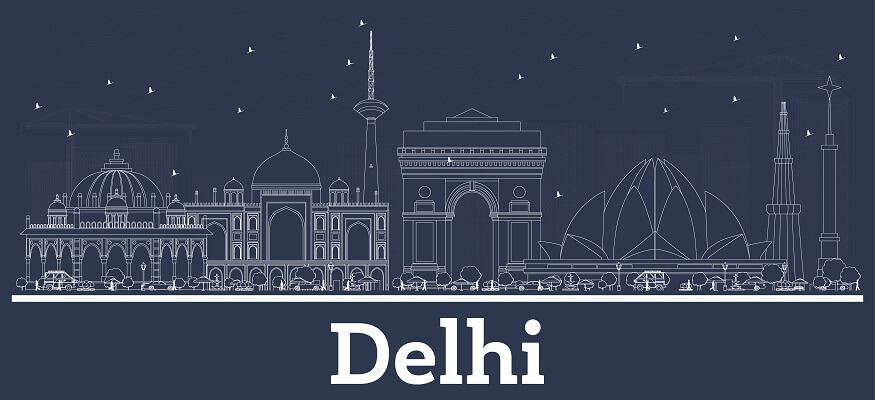Delhi! As we all know, it is India’s capital territory. Delhi is located in the north of India and has a massive metropolitan area. Delhi is divided into two distinct areas – New Delhi and Old Delhi. In Old Delhi, there is a neighborhood that dates back to the 1600s. It is the most historic part of the metropolis, with its origins dating back to the time of the Mughals. It also houses the Mughal-era Red Fort, which is a symbol of India, and the sprawling Jama Masjid mosque. The courtyard of the masjid can accommodate up to 25,000 people at a time. Nearby is Chandni Chowk, a vibrant bazaar filled with food carts, sweet shops, and spice stalls. While they continue to grow side by side, each retains its own charms. There are several monuments to visit in Delhi.
Besides all that has been mentioned above about Delhi, it holds great historical significance to the country India. It is an important commercial, transport, and cultural hub for the citizens, as well as the Indian political center. According to resources, they named the city after a king named “Raja Dhilu,” who reigned in the region in the 1st century BCE.
Now, New Delhi is one of the most widely known areas of the city. Its rich and unique heritage and culture are responsible for the city being as famous as it is. The town has grown tremendously over the years. In the whole of Delhi, there are several unique and beautiful monuments present. Since Delhi is also known for being the country’s political hub because the Parliament of India is based there and is among the famous things in Delhi to visit. The parliament divides into the Rajya Sabha and Lok Sabha. British designers constructed it in 1927, making it one of the beautiful monuments to visit in Delhi.
All together, the ASI in Delhi has recognized 174 Monuments of National Importance that are famous in Delhi. Now that we know so much about Delhi, let us have a peek into the historical monuments in Delhi that are proudly considered heritage monuments in Delhi.
- The Qutub Minar: People also spell it as Qutb Minar and Qutab Minar. It is a victory and a minaret tower and is a part of the Qutb complex. It lies at Delhi’s oldest fortified city site, Lal Kot, which was founded by the Tomar Rajputs. Experts consider it a UNESCO World Heritage Site located in the Mehrauli area of South Delhi, India. Qutub-ud-Din Aibak built the Qutub Minar in 1193, and it stands as a 73-meter-high tower. The builders constructed it to celebrate the Muslim dominance in Delhi.
- The India Gate: It is a war memorial located near the Kartavya path, which was formerly called the Duty Path. It is on the eastern edge of the ceremonial axis of New Delhi.
- Raj Ghat: It is dedicated to Mahatma Gandhi and is a memorial in Delhi, India. In Old Delhi, the name of a historic ghat was originally just “Raj Ghat,” but to the east of Daryaganj, there was Raj Ghat Gate, which formed a walled city. The opening at Raj Ghat was to the west banks of the river Yamuna. The whole memorial area was later called Raj Ghat.
- Jantar Mantar: It means “instruments for measuring the harmony of the heavens.” It is located in the modern city of New Delhi. It consists of 13 architectural astronomy instruments. Height is 723 feet (220 m). It was founded by Maharaja Jai Singh II and built in the year 1724.
- Purana Qila: which translates to Old Fort, is one of the oldest forts in Delhi. It was believed that ‘The Lion King’ Afghan Sher Shah Suri and Humayun built the present citadel at Purana Qila. It seems to be an excavation site that has traces from the 3rd century BC, which was the pre-Mauryan period.
- Jama Masjid: Mughal emperor Shah Jahan built the Jama Masjid between 1650 and 1656, at the highest point of Shahjahanabad. Ustad Ahmad Lahori designed the mosque. He died in the year 1649 before its construction even started. It was later completed by Ustad Khalil, an architect, and it took approximately 5000 workers to construct it.
- The Red Fort: or Lal Qila is a historic fort in the neighborhood of Old Delhi which has historically served as the main residence of the Mughal emperors. The construction of the Red Fort was commissioned on 12th May in the year 1638, by the Emperor Shah Jahan. He made this decision because he wanted to shift his capital from Agra to Delhi. The Red Fort Complex was built as the new capital of the fifth Mughal Emperor of India, Shah Jahan. It was a palace fort of Shahjahanabad named for its massive enclosing walls of red sandstone. There was an older fort called the Salimgarh, which was built by Islam Shah Suri in the year 1546, which is adjacent to the Red Fort Complex.
- Humayun’s Tomb: Delhi is the first of the grand dynastic mausoleums that were to become synonyms of Mughal architecture, with the architectural style reaching its zenith 80 years later at the later Taj Mahal. Humayun’s Tomb stands within a complex which is located in New Delhi’s Nizamuddin East neighborhood. Haji Begum not only chose the Persian architects who built the monument but also the location. In proximity to the dargah of a popular Sufi saint Nizamuddin Auliya, lies a UNESCO World Heritage Site, which is Humayun’s Tomb on the banks of the river Yamuna.
- Rashtrapati Bhavan: It was originally built to serve as the residence for the Viceroy of India. The Viceroy’s House, as it was called then, has changed into what we call today Rashtrapati Bhavan. It is today emblematic of Indian democracy and its secular, plural, and inclusive traditions, which once was all about being a symbol of imperial domination and power.
- The Lotus Temple: located in New Delhi, India. It was a dedicated Baháʼí house of worship, a temple of the Baháʼí faith. The Lotus Temple was consecrated and opened to the public on 13th November 1986. Its lotus-like shape that goes unnoticed has become a prominent attraction in the city. Like all Bahá’í houses of worship, the Lotus Temple is open to everyone, regardless of one’s religion or caste, creed, qualification, or any other belief. An Iranian architect named Fariborz Sahba designed the lotus temple, who was praised and won many accolades for the design and the whole project even before the temple was completed. It has surely received several awards. The Lotus Temple derives its name from its very design.
Now those were some extravagant monuments to visit in Delhi. Usually, we plan vacations to visit famous monuments and places around the world, but we fail to realize that there are jewels hidden within our reach. India has an enormous story to tell the world, but what she needs is storytellers. Hence, here at EuroSchool, we encourage our students and their parents to explore the unimaginable heritage monuments in Delhi and in the whole of India. The monuments in Delhi are surely one of a kind, but each historical monument in Delhi tells you a fascinating story that would remain untold if we do not encourage our future generation to explore the historical monuments in Delhi.
For more such informative blogs, please visit our website.










